Building a home for birds on Maryland’s Poplar Island
Biologists collect discarded Christmas trees to build bird nesting habitat on a restored island in the Chesapeake Bay.
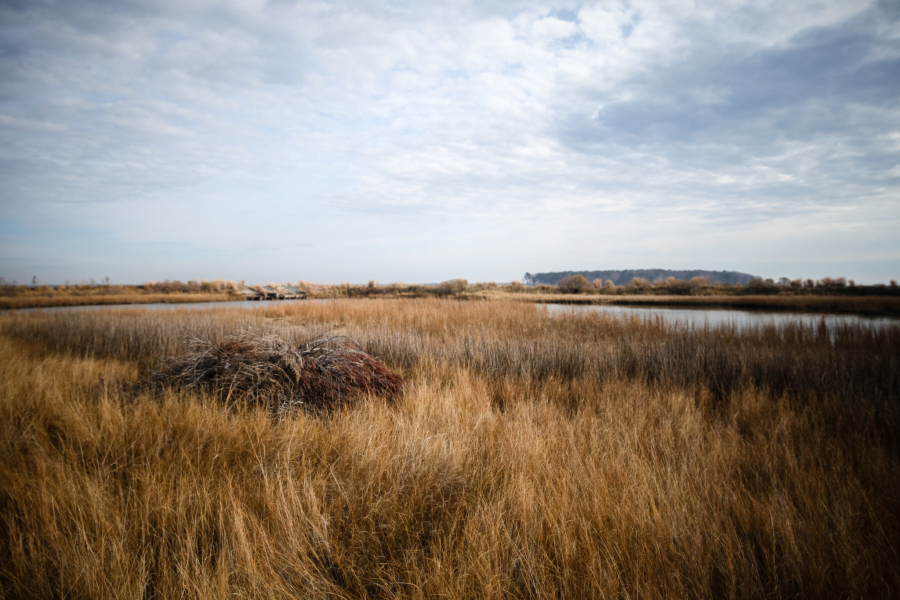
"Everything you film today, everything on camera, everything you walk on, was created. None of it was here in 1998. We’d be in several feet of water right now a little more than a decade ago." – U.S. Fish and Wildlife Service Biologist Chris Guy
It’s warm for a January morning. But out of habit, the team from the U.S. Fish & Wildlife Service Chesapeake Bay Field Office (FWS) is armed with coffee thermoses and dressed in construction-orange floatation gear. The hot coffee and “survival suits” gain importance as the winter wind stings our faces on the hour-long boat ride from Annapolis to Maryland’s Eastern Shore. The team embarks on this trip most mornings throughout the year, even in the coldest months.
In fact, today’s task must be completed in the first weeks of the new year. We’re hauling discarded Christmas trees to build waterfowl habitat on Poplar Island, a place where, 10 years ago, wildlife habitat had nearly disappeared—because the land had disappeared. In 1997, just 10 acres of the original island remained.
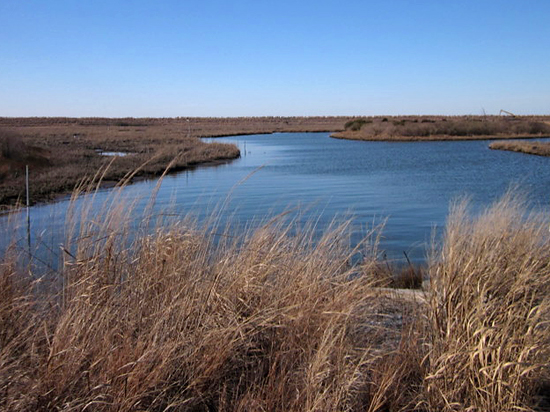
Today, Poplar Island has grown to 1,140 acres, thanks to a partnership between FWS, the U.S. Army Corps of Engineers, Maryland Environmental Service and Maryland Port Administration that uses dredge material from the Port of Baltimore to rebuild the island. Many places (such as parts of Washington D.C. and Philadelphia International Airport) have been “built” using this technique, known as “fast-landing.” But Poplar Island is distinctive: it’s being constructed not for human use, but to provide the Chesapeake Bay’s wildlife with island habitat, a rarity in an era of quick-sinking shorelines and rising sea levels.
“What's unique about this project is the habitat aspect,” says FWS biologist Chris Guy, who’s helped run the project since 2005. “It's a win-win, because you get a dredge disposal site, which is hard to come by in the Chesapeake Bay, and it's long term, and you're getting much-needed habitat restoration.”
According to FWS biologist Peter McGowan, who began working on the project in the mid 1990s, wildlife are now flocking to Poplar Island. “Back in 1996, we had ten documented bird species using the island,” he says. “Now we have over 170 species that have been documented, and over 26 nesting species.”
Every January since 2005, residents of Easton, Maryland, have put their old Christmas trees on the curb for trash pickup, unaware of the fact that their discarded holiday greenery will soon become shelter and nesting habitat for black ducks, snowy egrets, red-winged blackbirds and diamondback terrapins.
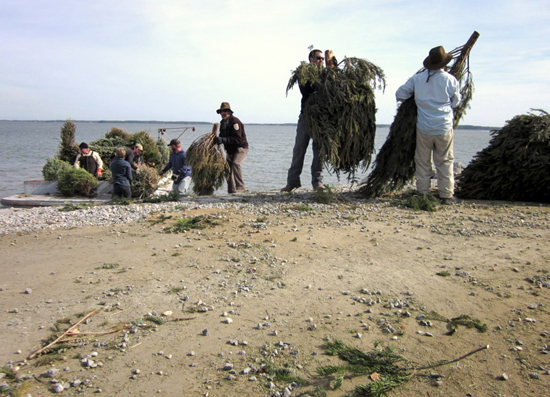
Poplar Island: A timeline
Like so many Chesapeake Bay islands before it, Poplar Island fell victim to both rapid sea level rise and post-glacial rebound: the counteraction of glaciers during the last Ice Age that’s making the Bay’s islands sink. The combination of rising water and sinking land caused shorelines to quickly erode, and eventually vanish.
Here’s a summary of Poplar Island’s life, near death and revitalization:
- 1847: Poplar Island is over 1,000 acres and home to a community of three hundred people.
- Early 1900s: Poplar Island splits into three separate land masses. The northernmost island is known as “Poplar.”
- 1930s: President Franklin D. Roosevelt and President Harry S. Truman form the Jefferson Island Club, a group of Democratic politicians who vacation on Poplar Island. The island has eroded to just 134 acres.
- 1990s: Just 10 acres of Poplar Island remain
- 1997: Maryland and the federal government begin rebuilding the island using processed dredge material.
- 2012: Poplar Island has grown to 1,140 acres.
- 2027: Construction of Poplar Island will finish. In all, 735 acres of wetlands, 840 acres of uplands and 140 acres of open water habitat will be constructed.
From disappeared to dredge-land
How do scientists and engineers turn open water into land you can confidently step on? With dried and processed dredge material that’s used to build up the land over time.

Dredging is a process of clearing sediment (dredge) out of the bottom of waterways. Dredging is necessary on many rivers leading into major ports because sediment naturally builds up over time. This sediment must be excavated so large ships can pass in and out of ports.
Maintenance dredging of the Port of Baltimore is critical to Maryland’s economy: the port contributes $1.9 billion and 50,200 jobs to the state’s economy. It’s also the number one port in the U.S. for automobile exports.
It also contributes a lot of sediment. The port estimates that maintenance dredging in the next twenty years will generate 100 million cubic yards of sediment—enough material to fill the Louisiana Superdome 25 times. Finding a place to store this massive amount of dredge material has been a problem—that is, until the Poplar Island project came calling, requiring 68 million cubic yards of dredge.
When dredge material arrives at Poplar Island through large pipes, it spends a few years drying. Then bulldozers and heavy equipment move in to dig out channels for wetlands and streams. When the topography is set, the area is planted with grasses, trees and shrubs.
A first time visitor to Poplar Island may be surprised to see bulldozers and pipes gushing black dredge material at a site renowned as a world wonder of habitat restoration. Although it’s necessary to use this heavy equipment to rebuild the island, the staff has found a way to balance these activities and still attract wildlife.
“Let's call it a ‘dance,’” says Guy. “We have to work with the construction, obviously, but we have to be sensitive to the needs of the birds.”
Christmas presents for black ducks
The Christmas trees that Guy and McGowan have been bringing to the island since 2005 give black ducks a place to lay their eggs. Black duck populations have fallen dramatically in the Chesapeake Bay region, causing the bird to be listed as a species of concern.
One reason for the species’ decline is a lack of food, including bay grasses, aquatic plants and invertebrates that have dwindled as pollution increased. Development and other human activities have encroached on its wintering and breeding habitats.
“[When we began the project], we looked at what others around the country used to attract nesting birds,” explains McGowan. “Christmas trees were a good resource. Instead of going into landfills, they could be reused.”
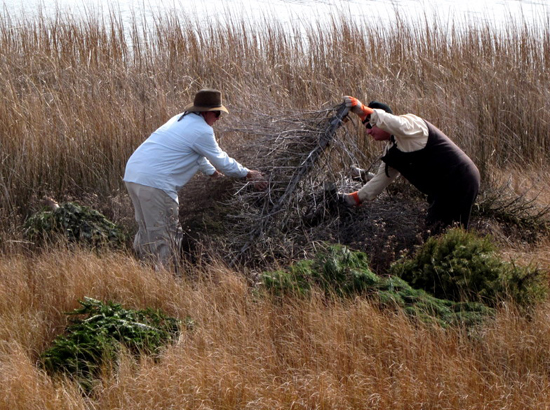
Discarded Christmas trees imitate shrubs that black ducks typically seek out. They’re warm, sheltered spots to raise young. Since the first tree plantings on Poplar Island took place just ten years ago, none are mature enough to provide adequate nesting habitat. So until the real trees grow tall enough, Christmas trees will have to do.
“Black ducks like to nest in thickets in the marshes,” McGowan explains. “Christmas trees help provide the structure they need. It keeps them covered and safe from predators.”
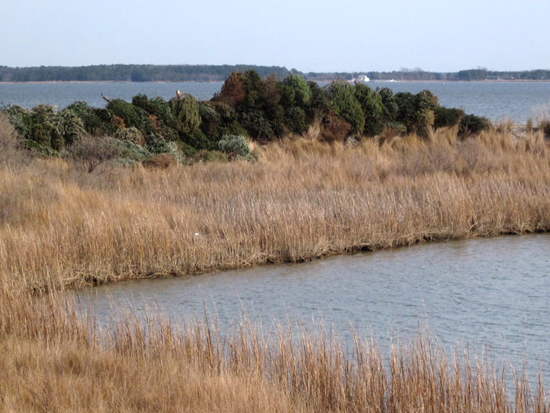
And the trees seem to be working. As we take apart last year’s piles, we find a handful of eggs underneath the dead trees.
“Seeing that we have these leftover eggs demonstrates to us that ducks are using these nest piles successfully,” says Guy. “Just about every one of them we find a few eggs, so we think they’re having multiple clutches.”
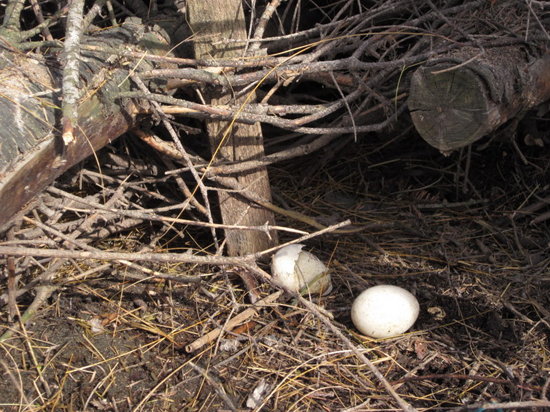
The eggs we find in the six or seven piles that we disrupt belong to mallards, but McGowan and Guy claim that black ducks are nesting on Poplar Island as well.
“We've had six or seven black ducks nesting on the island,” says Guy. “You may say six or seven isn't a big deal, but when you're down to the last few hundred black ducks nesting in the Bay, going from 0 to 6, where they're used to be thousands, that's a big success story. That's not the only thing that these trees do, but it's one of the main drivers to get these trees out here.”
Small start, big impact
Guy and McGowan have long envisioned Poplar Island as prime habitat for black ducks.
“Back [in 2005], we went around the curbs in Anne Arundel County and threw the trees in the back of my pickup,” Guy tells me. It took the pair the entire month of January to collect the trees and transport them to Poplar Island.
Seven years later, the project is finished in just one day with help from Easton Public Works and volunteers and employees from FWS and Maryland Environmental Service.
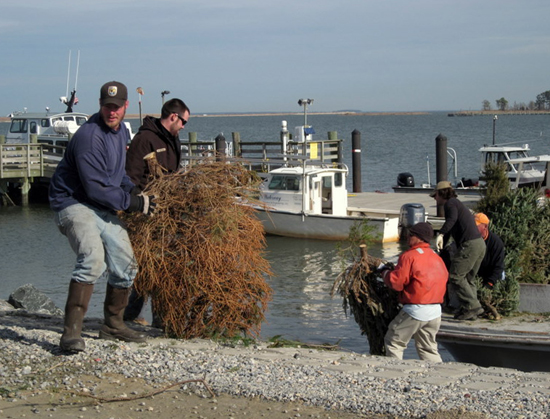
Black ducks aren’t the only critters on Poplar. The island is home to hundreds of birds, reptiles and other species that now rely on the restored landmass for food and shelter.
- Newly hatched diamondback terrapins, Maryland’s state reptile, also use the Christmas trees as shelter from predators. Although terrapins are not threatened or endangered, Maryland lists them as a species of concern.
- The only nesting colony of common terns in Maryland’s portion of the Bay is located on Poplar Island. This year, biologists used a combination of decoys and audio calls to attract a handful of terns to the island. But the project needs to continue for a few years before terns are comfortable enough to return on their own.
- Snowy egrets also take advantage of the Christmas trees and are attracted to Poplar Island with decoys.
- Bald eagles, osprey and great blue herons are just a few of the many other bird species that use Poplar Island.
For more information about Poplar Island and other wildlife habitat restoration projects around the Chesapeake Bay region, visit the U.S. Fish and Wildlife Service’s Chesapeake Bay Field Office website.
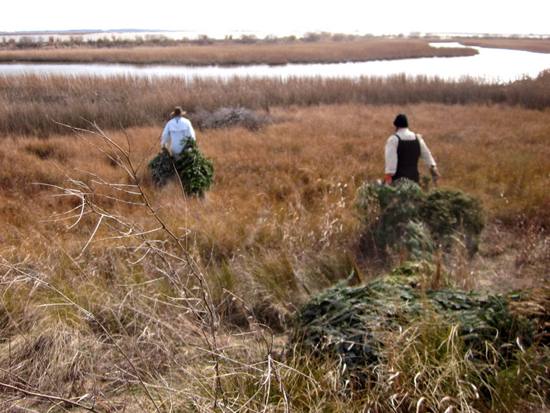

Comments
That is such a wonderful thing all of you have been doing! God bless you all for your unselfishness. I hope I can come and visit from Alabama as Maryland will always be my home
Much love,
Marcy LaFavor
Really wonderful..I hope ONE DAY some of us can take a trip there. In the
1930s, my father took President Hoover and Roosevelt there on the Sequoia, the Presidential Yacht. There was a lodge there for meetings and etc.
Thank you!
Your comment has been received. Before it can be published, the comment will be reviewed by our team to ensure it adheres with our rules of engagement.
Back to recent stories